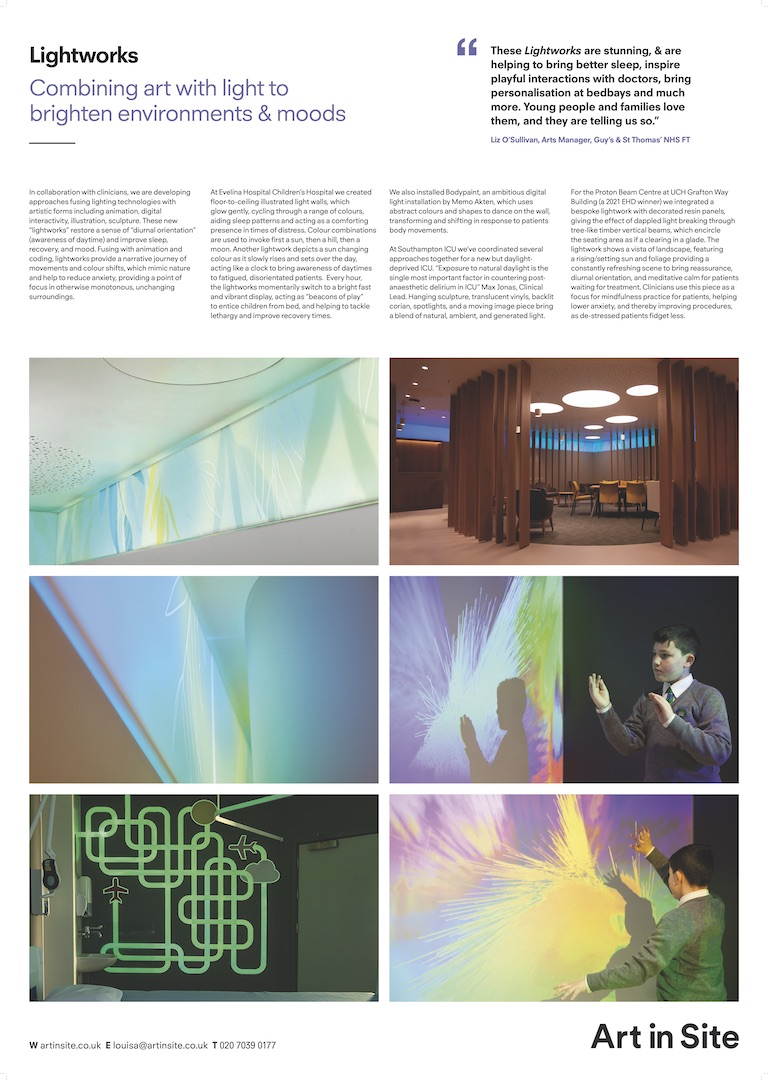Healthcare / Arts and health
European Healthcare Design 2022
“Lightworks”: Combining art and light to combat the clinical dark age
By SALUS User Experience Team | 04 Oct 2022 | 0
We are living in the “clinical dark age”, where hospital lighting – often harsh, artificial, monotone, overhead, sometimes absent – is at odds with medical aims, affecting sleep, wellbeing, diurnal rhythms, recovery, and adding to stress, disorientation, and lethargy.
Abstract
In collaboration with clinicians, we’re developing approaches fusing lighting technologies with artistic forms, including animation, digital interactivity, illustration, and sculpture. These new “lightworks” restore a sense of diurnal orientation and improve sleep, recovery and mood. Fusing with animation and coding, programmed lightworks provide a narrative journey of movements, subtle fades and complex hues, which mimic nature and help reduce anxiety, providing a mesmerising point of focus in otherwise monotonous, unchanging surroundings.
Projects and case exemplars:
Evelina Hospital Children’s Hospital: 3m x 3m floor-to-ceiling illustrated Corian ‘day and night lights’ glow gently, cycling through a range of colours, aiding sleep patterns, and acting as a comforting presence in times of distress. In the ICU, a lightwork combines two separate zones, which fade through colour combinations to give multiple impressions – eg, first a sun, then a hill, then a moon. Another lightwork depicts a sun changing colour as it slowly rises and sets over the day, acting like an illustrative clock to bring temporal orientation for fatigued, disorientated patients. Every hour, these lightworks momentarily act as “beacons of play”, enticing patients from bed after an operation with funky displays of light and colour – helping to tackle lethargy and improving physical recovery times.
UCLH – Proton Beam Therapy Centre: Patients travel six floors underground to receive proton-beam cancer therapy – a daunting prospect akin to entering a daylight-deprived bunker. We integrated a bespoke lightwork with routered resin panels on opposing waiting room walls, giving the effect of dappled light breaking through tree-like timber vertical beams, which encircle the waiting chairs like a glade. The lightwork shows a vista of landscape, featuring a rising/setting sun and foliage providing a constantly refreshing scene to bring reassurance, diurnal orientation, and meditative calm for patients waiting for treatment. Clinicians plan to use this piece as a focus for mindfulness practice for patients, helping lower anxiety, and thereby improving treatment procedures/times (as de-stressed patients fidget less).
Bodypaint Children’s Emergency: Bodypaint is an ambitious digital light installation, which enables play, distraction and delight for everyone in the wait area of the ED. A dynamic interplay of abstract colours and shapes appear to dance on the wall, which transform and shift in response to body movements. “Before the refurb there used to be an old TV, which no one watched. Since the introduction of Bodypaint, children move around and dance, and create this beautiful sequence of colours on the walls.”
Southampton ICU: “Exposure to natural daylight is the single most important factor in countering post-anaesthetic delirium in ICU”, says clinical lead Max Jonas. To meet this need, we’ve co-ordinated several approaches for a new yet daylight-deprived ICU. Hanging sculpture, translucent vinyls, backlit Corian, spotlights, and a moving image piece bring a blend of natural, ambient and generated light. The clinical benefits of our work – orientation, anti-delirium, aiding recovery times, and boosting staff morale – are discussed.
Conclusions and implications
- lightworks bring emotional/functional “win-win” benefits – eg, better sleep / faster recovery, and calmer patients / smoother diagnostics;
- lightworks establish slower-paced stimulation (colour changes and transitions), reducing brain-chatter and helping put patients into mediative state;
- lightworks are superior to TVs, providing a planned, captivating sensory journey that reduces anxiety and adrenalin, rather than spiking it (as TVs do); and
- programmed lightworks are flexible and can be tweaked as feedback/interests of clinicians change.
Lightworks appeal across age and ability ranges. Bodypaint is enjoyed by everyone – from autistic children to older adult carers.
Organisations involved


